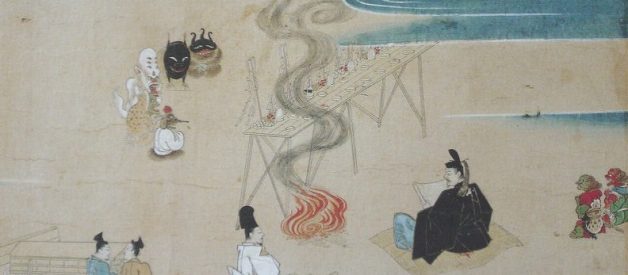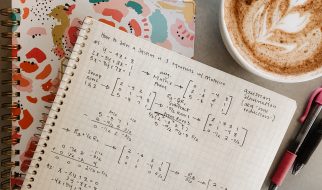Onmy?d?, Shikigamis, Occultism and Eastern Witchcraft
It is believed that it began at some point between the sixth or seventh century of the Common Era, a popular magical practice in Japan that went as far as having its own ministration and ruling official decision-making in government decisions. Using prevailing methods in the Taoist practices brought about by Buddhist monks, and a way of thinking that incorporates the yin-yang balance and the five elements, the practice gradually began to pick up. Over the years, it has been refined to incorporate elements of what was then cutting-edge technology in order to extend its practices to reading stars for divination. Onmyouji used principles similar to modern feng shui to find auspicious placement for buildings, especially government buildings, and they were also often consulted on supernatural issues such as haunts, possessions, and curses. The practice, then a proto-renaissance blend of scientific values ??mixed with oriental root mysticism, became popular down to the state level, and was called Onmy?d?.
The Yin-Yang Path, another name for magical art, was under the control of the Tsuchimikado family, the emperors, until the mid-19th century, when it was banned as superstition. In 2006 the ban was abolished and the study on the subject was free. Despite little western knowledge, in Japan is a very famous concept, full of legends that permeate the culture and childhood of most japanese. Symbols such as the figure of the paper or origami gods, the Shikigamis, familiar spirits controlled by Onmy?d? practitioners, the onmyojis (???).
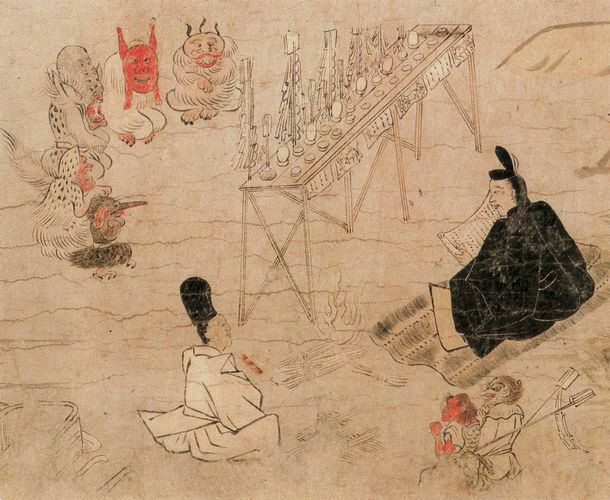 Onmyojis in magical work, unknown author
Onmyojis in magical work, unknown author
In Chaos Magic the concept of family spirit is recognized and common, but, as in other ancient traditions, the making of its shikigami was of much greater complexity. Knowledge is restricted and untranslated in the western world. But it would be as the magician and quadristrict Bluefluke defines, probably ?nonlocal spirits,? unlike the making of the caoist servants. In the manga and anime Ghost in the Shell, there is the citation of onmyoji-based supernatural event professionals who, despite being caricatured people with a credibility not far from western esotericism, carry the legacy of a very popular character in japanese culture and mysticism, and mainly responsible for the popularization of Onmy?d?.
Abe no Seimei
Abe no Seimei was an onmyouji born from the Heian Period (around the 900s). Its history is surrounded by myths, which is why it is considered a legend, and also for being the protagonist of a famous japanese fiction called ?Onmyoji? by Baku Yumemakura. But his fables resemble another recognized figure of modernity, Rasputin, a wizard who aided the Tsars in the russian pre-revolution. Seimei worked as an onmyouji for the emperors and government of the Heian Period, making calendars, predicting astronomical events, and advising on which spiritual way best to deal with problems, as many magical advisers of european or even chinese courts did, but at a time when the country was quite closed, though much of the basis of magical art came from chinese culture. He lived about 80 years, free of serious diseases, which contributed to the popular belief that he possessed mystical powers. His fame has spanned centuries, and he is known today as the greatest onmyouji in the history of Japan.
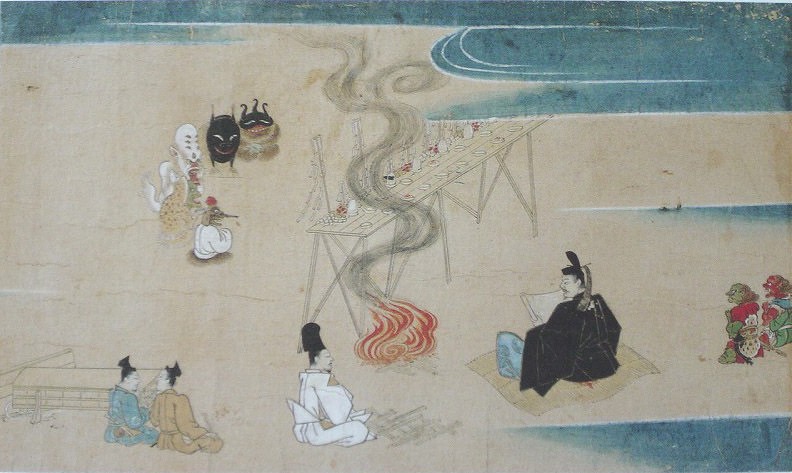 Abe no Seimei worshiping god that drives away evil spirits, painting from the Heian period
Abe no Seimei worshiping god that drives away evil spirits, painting from the Heian period
His genealogy is not very clear. He may have been descended from the poet Abe no Nakamaro, son of Abe no Yasuna. His mother, however, would be a kitsune (fox) who would be a type of Youkai (supernatural creature, or demon as we call it in the west). Abe no Seimei was then a han?you, a half-youkai (half demon, or supernatural creature).
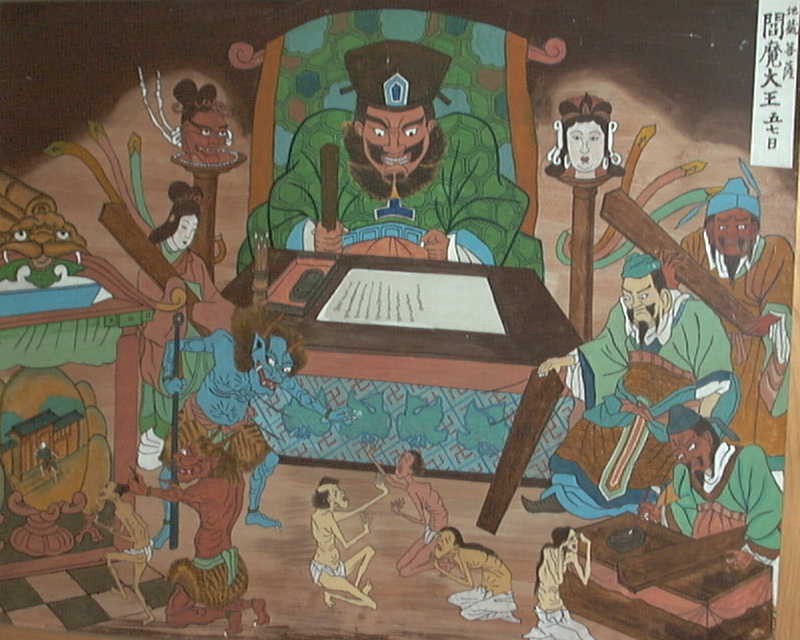 Abe in Seimei performing Taizan Fukunsai, ritual to control death, author unknown
Abe in Seimei performing Taizan Fukunsai, ritual to control death, author unknown
He became famous especially when he was called to predict the fortunes of Emperor Murakami, about 40 years old. Being then recognized by all the imperial nobility. Among his doings, he is believed to have had at least 12 shikigami throughout his life (being considered extremely difficult to obtain a single would be like mastering 12 powerful and independent entities at will). After Seimei passed away, due to his great merits, Emperor Ichij? issued an imperial decree in 1007 stating that a shrine to worship him should be built on the remains of his residence near the Ichijo Modoribashi (famous bridge for many legends with samurai and demons in Kyoto). He had two sons who were also famous onmyoujis. His home in Kyoto became the well-known temple called Seimei Jinja.
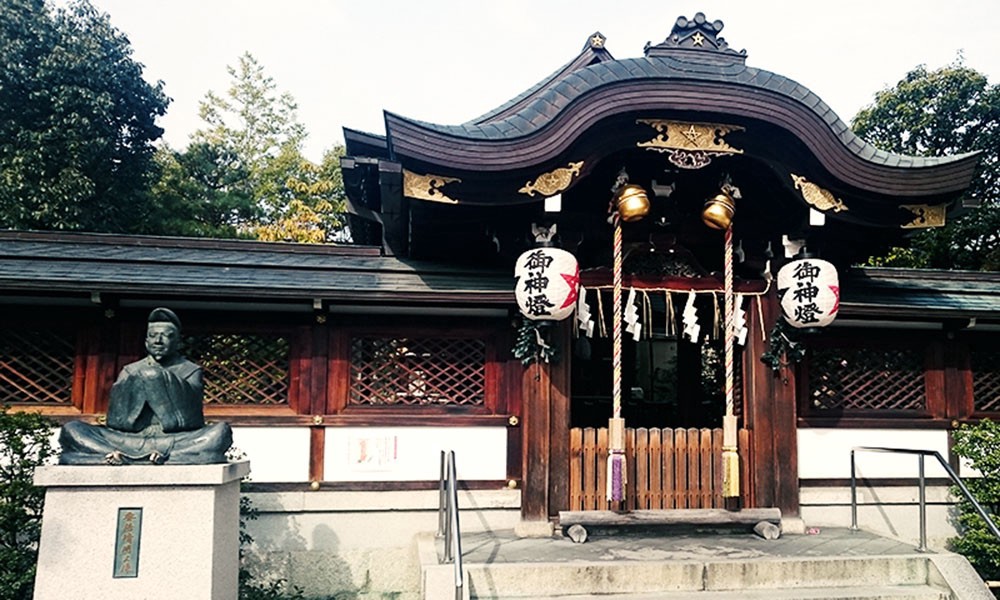 Seimei Jinja in Kyoto, unknown author
Seimei Jinja in Kyoto, unknown author
Yin-Yang and Wu Xing
Yin and Yang, sometimes referred to as the dark and the luminous, respectively, are two symbolic concepts that originate from observing nature: observing a mountain, the Taoists differentiated two sides in relation to light, the luminous side and the dark side. Yang represents the south side of the mountain, which is sunny; Yin represents the north side, which is in the shade. Also the Taoists observed the rivers, however, the north side is represented by Yang, because it is on this side that the light is reflected; Yin already represents the south side, which is in shadow. The crux lies, therefore, in the realization of a bright side and a dark side in nature, which generated the concept of Yin and Yang as two opposite forces of the universe, as two opposite polarities.
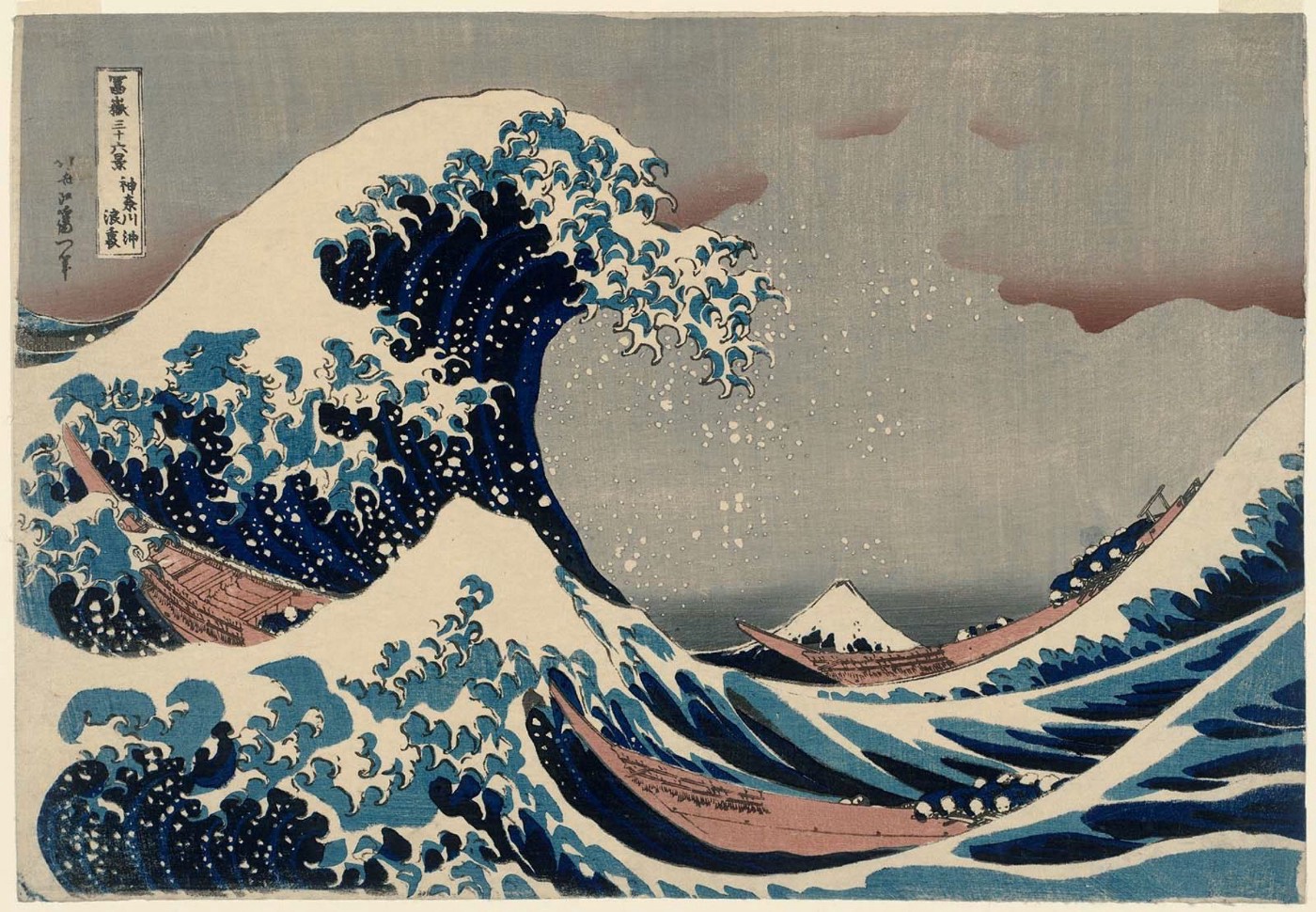 Great Wave of Kanagawa, Hokusai Woodcut
Great Wave of Kanagawa, Hokusai Woodcut
As the natural environment is known, changing weather and geographical conditions greatly influence physiological activities. This finding, visible especially in the seasonal epidemics of winter (flu, meningitis) or summer (diarrhea), has not gone unnoticed by biomedicine or traditional chinese medicine. This recognition has linked the physiology and pathology of organs and tissues to many environmental and natural factors. These factors are classified into five categories and similarities and allegories are employed to explain the intricate links between the external (macrocosm) and internal (psychic/affective) environment.
One begets Two, Two begets Three, and Three begets Ten Thousand Things. ? Lao Tzu
This conception was called The Five Element Theory and was established and systematized by naturalist Tsou Yen (Zou Yan) between 350 and 270 BC. He was the most outstanding member of the Chin Hsia Academy, and often called the ?founder of chinese scientific thought.?
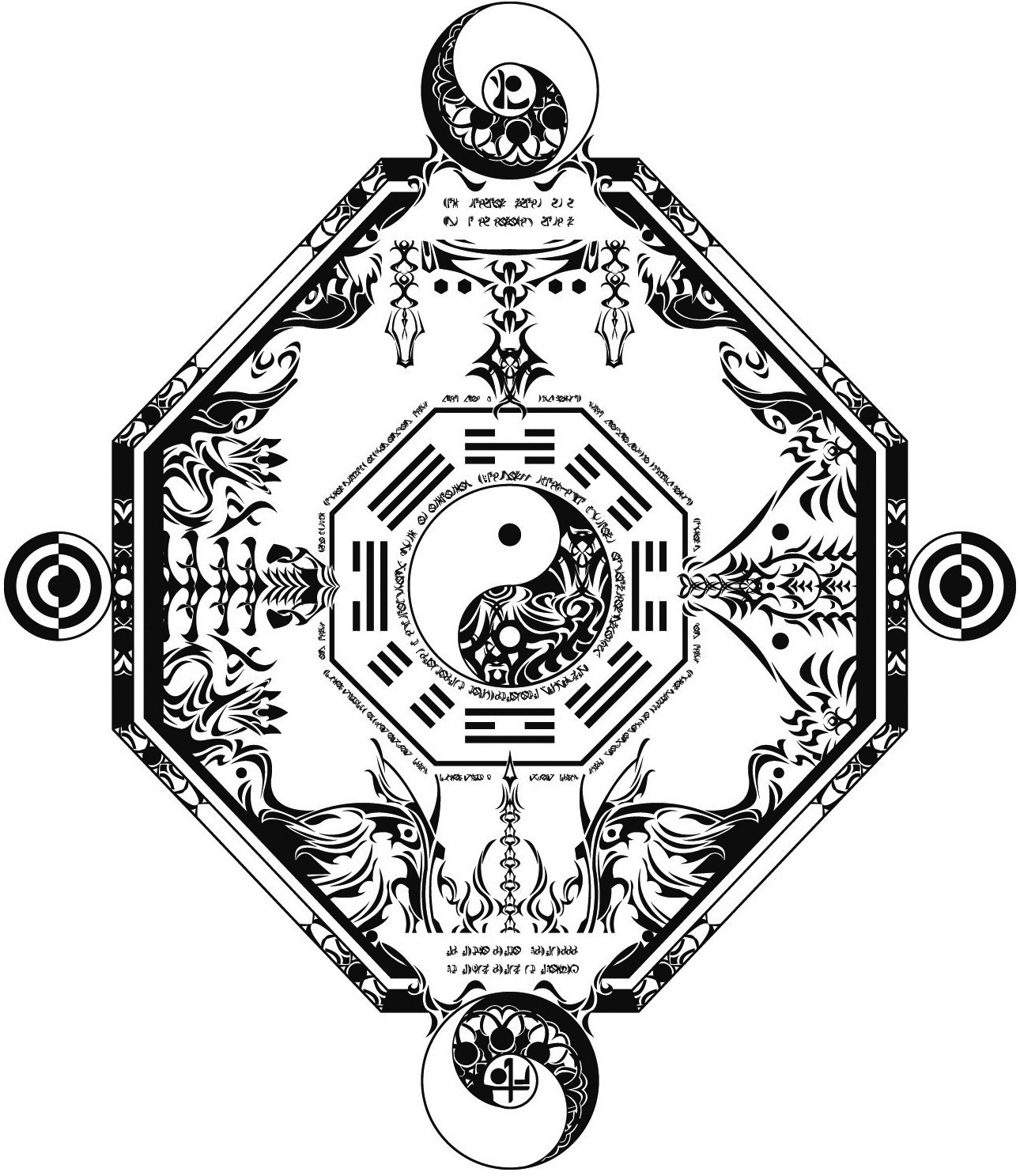 Graphic scheme of Wu Xing, unknown author
Graphic scheme of Wu Xing, unknown author
The theory of the five elements (or motions) states that wood, fire, earth, metal and water are the basic elements that make up the material world. There would be a reciprocal interaction and control between them that would determine their state of constant movement and change. In this theory that establishes a set of matrices, all things can be classified according to these elements or the relationships between them.
Syncretism and Onmyojis
Onmy?d? merged with occultism and other beliefs, and evolved from Chinese thinking, imported from a syncretism in Japan. Japanese Onmy?d? took elements from Taoism (from the I Ching), which was transmitted to Japan at the same time as Onmy?d?, including magical elements such as katatagae (magical practice that sought directions to be avoided based on a vengeful divination system of the compass-related Konjin metal god), monoimi (a specific abstinence practice), henbai (a special protective ceremony) and ceremonies to the Taoist gods, as well as the Taizan Fukunsai (a spell to give control over death and souls that can be resurrected and killed). Elements of feng shui and the medical art of jukond? (kind of herbal medicine) were also incorporated, and as Onmy?d? and Japanese Shinto influenced each other, it grew in a characteristic way. From the end of the eighth century onwards, it was influenced by the magical elements of esoteric Buddhism (mainly Tibetans, and Zen Buddhism) and of Indian astrology (Sukuy?d?), which were transmitted with it.
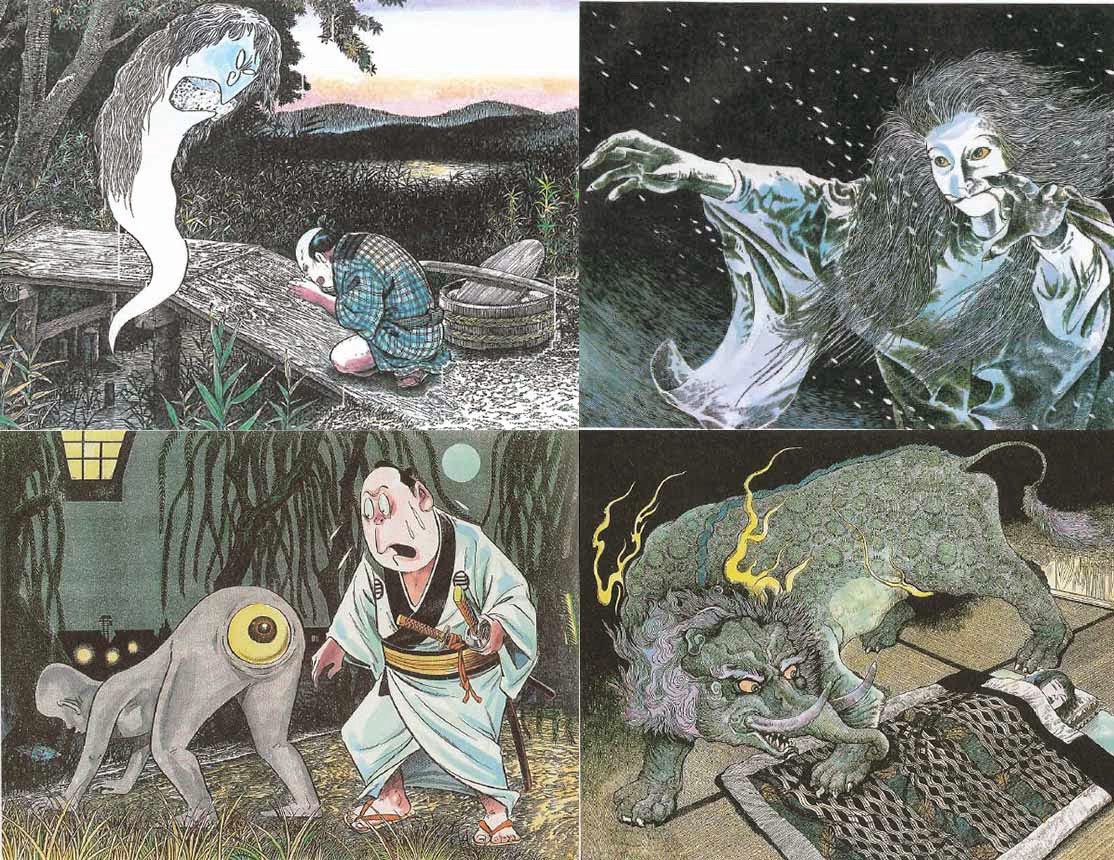 Shigeru Mizuki comics depicting legends of Youkais
Shigeru Mizuki comics depicting legends of Youkais
In the 5th and 6th centuries, the principles of yin-yang and the Five Elements were transmitted to Japan with Buddhism and Confucianism. As well as astronomy, calendar making, the calculation of time, prediction of the future, and studies based on nature observation (later gathered as divination processes). This divinatory process has been accepted in Japanese society as a technique for predicting good or bad fortune in the ordinary world. Such techniques were mainly known to Buddhist monks from mainland Asia, who were instructed in Chinese reading and writing. Under the demand of time from the members of the imperial court, who believed that the guesswork of the onmy?d? would be useful in decision-making, it became necessary for lay people to learn the art as well, and the onmyoji (magical art professionals) began to appear in the middle of the 7th century.
With the implementation of the Ritsuryo system of law codes, yin-yang techniques were placed under the jurisdiction of the Onmyo Secretariat of the imperial bureaucracy. The Onmyo Secretariat was responsible for overseeing Onmy?d??s divinations, astrological observations and the creation of calendars. In addition, by law, Buddhist clergy were forbidden to practice astrology and fortune telling. Thus government-controlled onmyoji began to monopolize the practice.
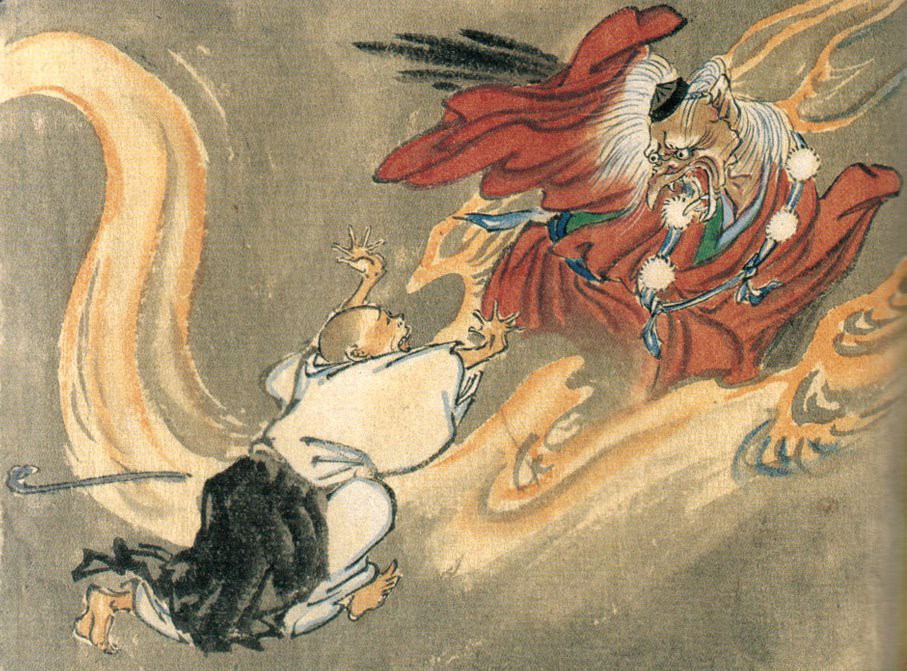 Shinigami mowing a life, unknown author
Shinigami mowing a life, unknown author
Since the late Heian period, imperial court society has assumed a more formal form and adherence to rituals to placate the souls of the dead with the intention of combating the creation of vengeful ghosts. Because the onmyoji came up with methods that prevent disaster with their divination and magic skills, superstition gave influence to the onmyoji over the personal life of the emperor and the court nobility. As a result, popular knowledge of onmy?d? gradually spread from court society to Japanese society as a whole, reinforcing its development into a typically Japanese art.
During the Heian period, the nobility organized their life around the practices recommended by the onmyoji. The practice of ?directions for luck and bad luck? is an example. Depending on the season, time of day, and other circumstances, a particular direction may be bad luck for an individual. If someone from the house was located accordingly, they were not advised to return directly to their home, but had to ?change direction? (katatagae) by going in a different direction and staying there. This person would not dare to go in the forbidden direction, but stayed where he was, even if it resulted in missing the court or overriding invitations from influential people.
Kami Path (link between Shinto and Taoism)
In prehistoric times, immigrants flowed to Japan sometimes in a stream, sometimes in a flood. They came from most of Korea and China through the Korean peninsula that was under Chinese influence. The result was that elements of Korean shamanism and Chinese popular beliefs entered Japan. The first was felt in miko-shamanism (Japanese charismatic shamanism) and the rock cult which is a hallmark of Shinto. The latter had an even deeper impact.
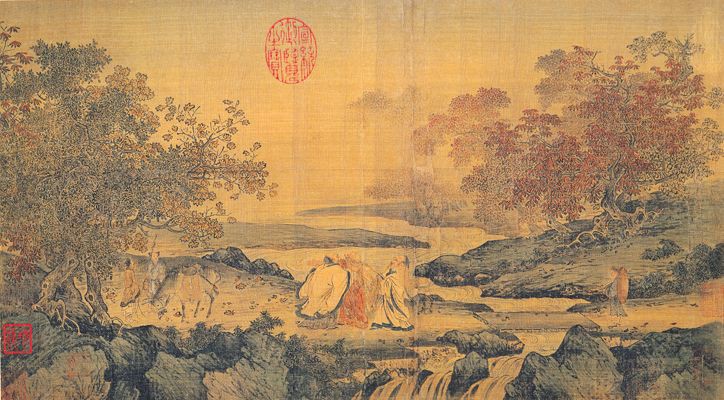 Three Caves, Daoist painting showing the union between Buddhism and Confucianism, unknown author
Three Caves, Daoist painting showing the union between Buddhism and Confucianism, unknown author
Chinese folk belief comprised a mixture of nature spirits and ancestral worship. It was based on a lunar/solar calendar, which was adopted in Japan, in commemorative festivals that sought to harmonize the human and spiritual worlds. This was the basis on which Taoism and Shinto developed.
By early 675 Japan already had a Yin-Yang Ministry (Onmyoryo) that advised the government on state affairs. Decisions were made according to star alignment, feng shui and complex divination techniques. Yin-Yang (onmyoji) wizards continued to play an influential role in the life of the ruling class. At this point Onmy?d? prospered.
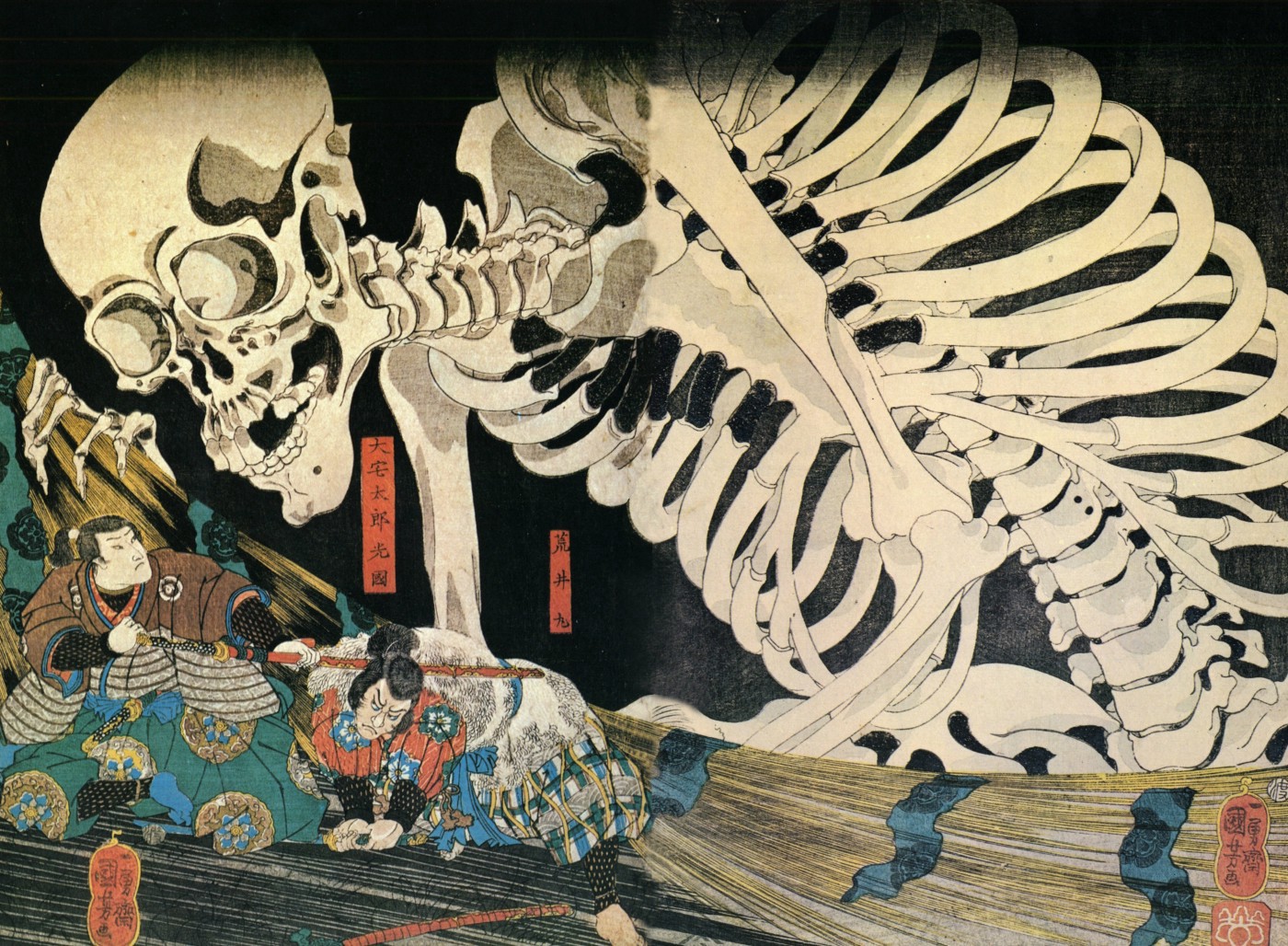 Shinigami, unknown author
Shinigami, unknown author
All of these developments occurred while known Shintoism was being shaped by the ruling class. As a result, imported ideas had a big impact. It is considered, for example, that 60% of modern Shinto ritual derives from Taoist and yin-yang practice. Purification rites, for example. The Yakudoshi (ritual for years of misfortune). The veneration of swords and mirrors. Divination and cave worship too. There was even influence on the very structure and naming of Shinto?s holiest shrine, Ise Jingu (jingu derives from a Taoist term for a room of worship).
Magic and Spells
Within Onmy?d? philosophy, spirits are invisible most of the time, but they can become visible through an amulet made of paper and magic writing. Some more powerful may show up in the form of small animals or birds. They are cast through a complex ritual and their powers are connected with the life force of their summoners. If the summoner is experienced and possesses great powers, his spirit may possess animals and even humans at the command of his master. If its summoner is inexperienced and weak, in time its spirit becomes self-conscious and runs out of control, killing its summoner as a form of revenge for imprisonment. These spirits are called Shikigamis, in free translation they would be like paper spirits, paper gods.
This practice closely resembles the goetic ceremonies described in Solomon?s minor keys, the Tibetan tulpas (from which part of the influence came), or the servants of Chaos Magic.
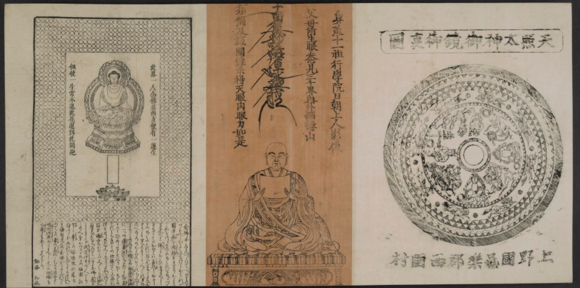 Ancient Buddhist Ofudas
Ancient Buddhist Ofudas
Another very common practice within Onmy?d? is making talismans for home protection. They are called Ofuda and their function is to ward off harms such as home accidents and disease. They are usually made of wood or paper and the writing must be done with archaic Chinese characters and red ink. This is true for all regions of the East, because it is preached that another form of writing carries no power whatsoever. Being written in a Chinese language does not mean that it was made in China, it is just a procedure for creating talismans. There is a portable version of this personal-effects talisman called Omamori whose creation procedures are the same as Ofuda.
Another interesting form of Taoist sorcery included in the Onmy?d? is called Kuji-In, a compilation of Buddhist charms and mudras for the purpose of protection and personal help when facing a demonic force or some kind of natural danger. This technique has spread among ninjutsu practitioners and is often mistakenly associated with this martial art.
Pop Culture
Today Onmy?d? is relegated to a place of mythological mysticism, and its practitioners are no different from western magicians in that they, in no way, have any differentiated social credibility. Magical art has influenced culture in many ways, especially in anime such as Shaman King and Naruto (Susano?o?s technique was as one imagined the power of the onmyoji). In Shaman King, the onmyoji are a type of high-level shaman. Characters include Yohmei Asakura, Yoh?s grandfather, and Hao. In addition, there is a book called ?Chou Senji Ryakketsu? written by Hao, known to contain powerful shamanic techniques (the book Senji Ryakketsu is a famous library of divination written by Abe no Seimei).
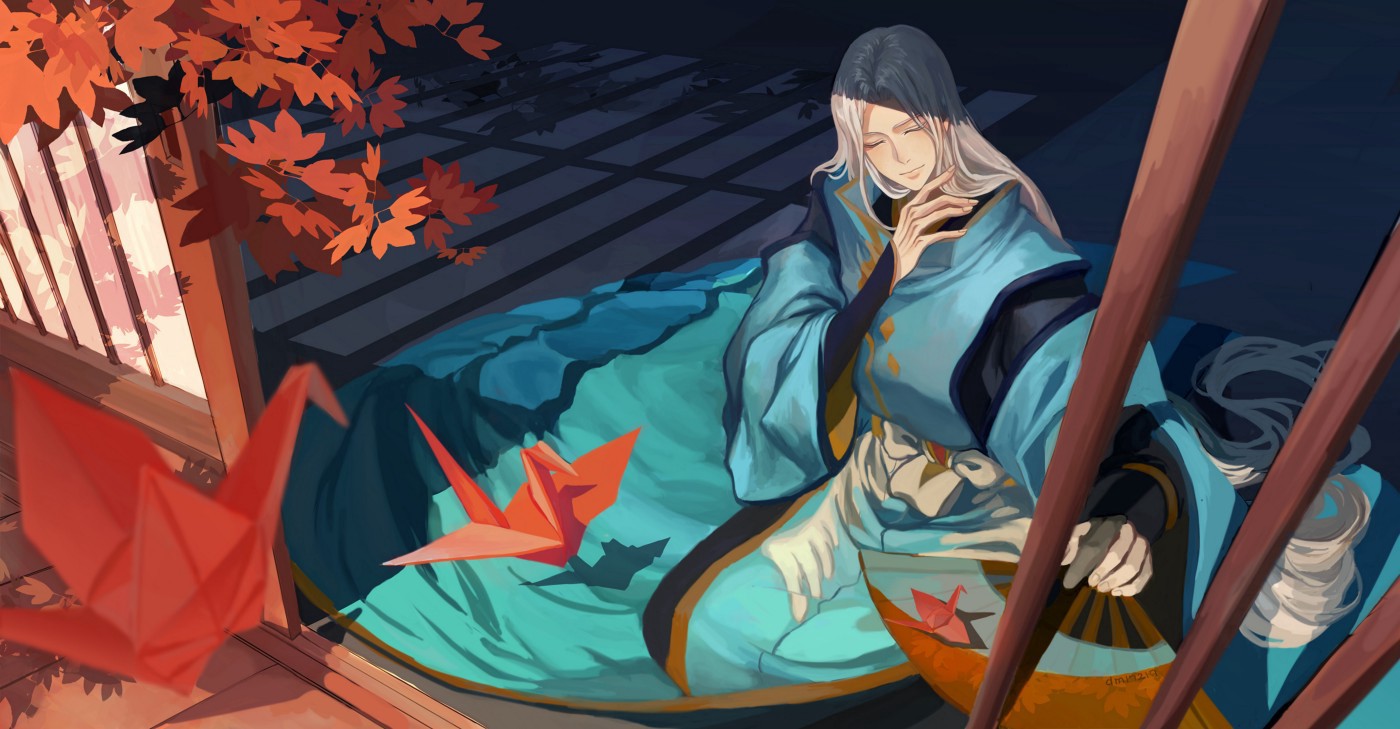 Abe no Seimei, from anime Shonen Onmyoji
Abe no Seimei, from anime Shonen Onmyoji
